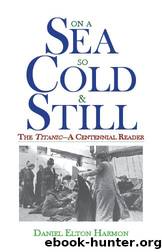On a Sea So Cold & Still: The TitanicâA Centennial Reader by Daniel Elton Harmon

Author:Daniel Elton Harmon [Harmon, Daniel Elton]
Language: eng
Format: epub
Publisher: Daniel Elton Harmon, Hornpipe Vintage Publications
Published: 2012-05-27T23:00:00+00:00
Chapter 10
Ismay: From Shipping Mogul
To Scapegoat
WOULD IT HAVE BEEN BETTER for the chairman and managing director of the White Star Line to have perished with the pride of his shipping fleet? In the judgment of millions of scorners then and now: a resounding yes. He must have wondered the same thing himself for the rest of his life. His eternal verdict and sentence, known only to him, was rendered by his Maker and Judge when Bruce Ismay did dieâquietly, of a strokeâ25 years after the Titanic went down.
Ismay, 49 years old at the time of the tragedy, was one of the visionaries whoâd plotted the building of the Titanic and her two sisters in 1907. Son of the lineâs founder, he was the logical target of commonersâ ire in the aftermath. He was haughty. A stickler for cleanliness, he was known to check for dust above the cabin doors of company liners. Accustomed to only finery in life, on the maiden passage he took one of the Titanicâs two ultimate parlor suites for himself (the suite that would have been J.P. Morganâs, had the corporate owner been aboard).
Then the worst thing that could happen to a modern imperator such as Bruce Ismay did happen: He survived the sinking of his own nautical masterpiece.
Ismayâs wife Florence and family stayed behind when he boarded the Titanic at Southampton; they opted for a Welsh holiday rather than a transatlantic voyage. To other first-class passengers, Ismay coyly asserted that he was just one of them. But his very presence, historians suspect, could have influenced decisions by the captain and officers, particularly in regard to the shipâs daily progress.
Afterward, as for insinuations that he personally pressed the captain to proceed at full speed on Sunday night despite ice warnings, Ismay told the British inquiry panel, âIf a man can see far enough to clear ice, he is perfectly justified in going full speed.â His obvious inference was that if the Titanic was going too fast for conditions at 11:40 p.m. on 14 April, the blame should be laid on those in commandânot their employer.
Ismay was one of 39 people lowered aboard Collapsible C, the next-to-last boat put away, minutes before the ship foundered. A sympathetic account of his climactic moment described Ismay and another man as simply stepping into the boat as it was being lowered, there being space available and no one else around. In the recollections of others, his exit from the sinking superliner was somewhat more energetic. Jack Thayer recalled the scene: âThere was some disturbance in loading the last two forward starboard boats. A large crowd of men was pressing to get into them. No women were around as far as I could see. I saw Ismay, who had been assisting in the loading of the last boat, push his way into it. It was really every man for himself.â
Ismay was branded a cowardâand an outrageously arrogant one. One newspaper headline demonized him as âThe Creature Ismay, Who Lived While Hundreds Died.
Download
This site does not store any files on its server. We only index and link to content provided by other sites. Please contact the content providers to delete copyright contents if any and email us, we'll remove relevant links or contents immediately.
Whiskies Galore by Ian Buxton(41937)
Introduction to Aircraft Design (Cambridge Aerospace Series) by John P. Fielding(33092)
Small Unmanned Fixed-wing Aircraft Design by Andrew J. Keane Andras Sobester James P. Scanlan & András Sóbester & James P. Scanlan(32764)
Aircraft Design of WWII: A Sketchbook by Lockheed Aircraft Corporation(32247)
Craft Beer for the Homebrewer by Michael Agnew(18196)
Turbulence by E. J. Noyes(7977)
The Complete Stick Figure Physics Tutorials by Allen Sarah(7338)
The Institute by Stephen King(6987)
Kaplan MCAT General Chemistry Review by Kaplan(6899)
The Thirst by Nesbo Jo(6877)
Bad Blood by John Carreyrou(6581)
Modelling of Convective Heat and Mass Transfer in Rotating Flows by Igor V. Shevchuk(6406)
Learning SQL by Alan Beaulieu(6237)
Weapons of Math Destruction by Cathy O'Neil(6214)
Man-made Catastrophes and Risk Information Concealment by Dmitry Chernov & Didier Sornette(5956)
Permanent Record by Edward Snowden(5795)
Digital Minimalism by Cal Newport;(5704)
Life 3.0: Being Human in the Age of Artificial Intelligence by Tegmark Max(5514)
iGen by Jean M. Twenge(5385)
